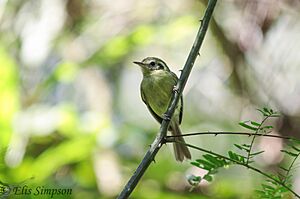São Paulo bristle tyrant facts for kids
Quick facts for kids São Paulo bristle tyrant |
|
|---|---|
 |
|
| Conservation status | |
| Scientific classification | |
| Genus: |
Pogonotriccus
|
| Species: |
paulista
|
 |
|
The São Paulo bristle tyrant (Pogonotriccus paulista) is a species of bird in the tyrant flycatcher family Tyrannidae. It was formerly placed in the genus Phylloscartes and known in English as the São Paulo tyrannulet. It is found in the southern Atlantic Forest region of South America. Its natural habitats are subtropical or tropical moist lowland forest and subtropical or tropical moist montane forest. It is threatened by habitat loss.
Taxonomy
The São Paulo bristle tyrant was formally described in 1907 by the German-Brazilian naturalists Hermann von Ihering and his son Rodolpho von Ihering. They placed it in the genus Phylloscartes and coined the binomial name Phylloscartes paulista. The type locality was specified as Salto Grande in the Brazialian state of São Paulo. The specific epithet is from São Paulo, the type locality. The São Paulo bristle tyrant was formerly known in English by the name São Paulo tyrannulet. A comprehensive molecular phylogenetic study of the suboscines by Mike Harvey and collaborators, published in 2020, found that the "São Paulo bristle tyrannulet" was embedded in a clade containing the bristle tyrants in the genus Pogonotriccus. Based on this result, the "São Paulo tyrannulet" was moved to Pogonotriccus and at the same time the English name was changed from São Paulo tyrannulet to São Paulo bristle tyrant. The species is monotypic: no subspecies are recognised.


